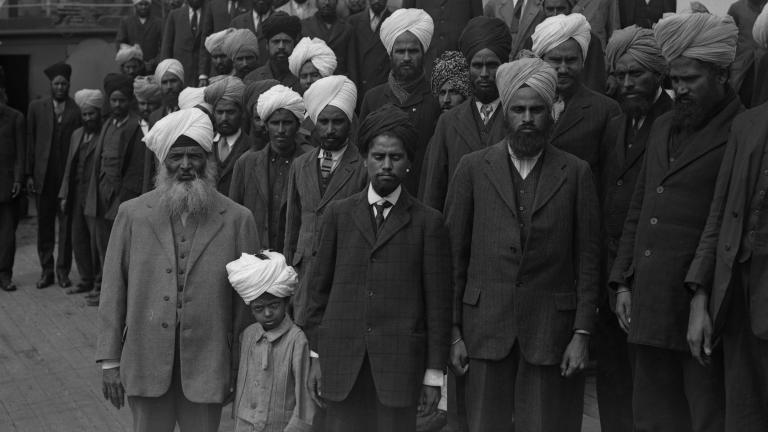"Our plane was actually the last plane that landed there – all the planes after were redirected,” she explained. “I just remember that we got off and all the lights were off, and I just felt really weird because that was one of the things our parents would tell us: In India the light goes out a lot, the electricity goes out a lot, but we won’t have to experience that in Canada. So, for that to be the first experience was totally weird."
It was a strange introduction to Canada, but Randhawa soon got used to her new country and her family flourished. It wasn’t until much later in her life that she learned about an ancestor who had experienced an even darker reception when he arrived in Canada.
That ancestor was Randhawa’s great‐great grandfather, Gurdit Singh, and his story is the story of the Komagata Maru. In 1913, Singh was an entrepreneur originally from Punjab, in India, working in Singapore. Whenever he went back to his village, he saw poverty and people struggling to get by and felt like he should do something to help.
When Singh was approached by Sikhs seeking to immigrate to Canada, he agreed to help. He chartered the Japanese ship Komagata Maru to transport these prospective immigrants across the Pacific Ocean. The ship set off from Hong Kong on April 4, 1914, carrying 376 Indian passengers – 340 Sikhs, 24 Muslims and 12 Hindus. Over a month later, on May 22, the Komagata Maru arrived on the coast of British Columbia. The ship and its passengers did not receive a warm welcome.
In 1914, many white Canadians were very hostile to non‐white immigration. In 1907, 10,000 people in Vancouver protested Indian immigration and then rioted through Vancouver’s Chinatown, scaring residents and destroying property. In 1908, the federal government made two provisions meant to prevent Indian immigration. The first required that all immigrants arrive in Canada by a continuous journey from their country of citizenship. Since there were no ships that made a continuous journey from India to Canada, this restriction effectively blocked Indian immigration. The second provision required Indian Immigrants to possess $200 upon arriving in Canada – eight times the amount required of white immigrants. In 1913, a lawyer in British Columbia successfully argued in court against these provisions, which led the passengers on the Komagata Maru to believe they would be able to immigrate to Canada.
The Canadian government had other plans. When the ship arrived, the strategy of local immigration officials was to deny Singh permission to land, thereby denying him access to banks and his money. They hoped to starve Singh of funds until he was forced to leave. The passengers, however, chose to present their case in court, and with the help of Vancouver’s Sikh community, they hired J. Edward Bird, the same lawyer who had successfully argued the case against the government provisions.
Canadian immigration officials did everything they could to stop Bird. They prevented him from having private meetings with the ship’s passengers. They also forced him to make his case to a panel of five judges instead of just one. At the same time, officials made life for the passengers very difficult, rationing supplies so that sometimes those onboard were forced to go 48 hours without food or water. On July 6, the judges decided against Bird, which meant the passengers on the Komagata Maru would not be admitted to Canada. On July 23, two months after it arrived, the ship was escorted out of Canadian waters by the HMCS Rainbow.
The Komagata Maru returned to India on September 26, 1914. British authorities suspected that the passengers were revolutionaries arriving to make trouble. There was an altercation between authorities and passengers, and shooting started. When it ended, 22 people were dead, including 16 passengers. More than 200 of the surviving passengers were imprisoned. Gurdit Singh was blamed for the massacre and went into hiding, but eventually decided to surrender. When Singh was released from prison, he began working peacefully for Indian independence alongside Mohandas Gandhi.
Singh’s great‐great granddaughter didn’t know anything about this story until she and her family took a trip to Vancouver when she was in middle school. "Before that, I didn’t really have an idea that there was any kind of wrongdoing in Canada’s past…. After learning about this, I realized there are actually a lot of things that have happened and there isn’t a lot of awareness about them. I feel like it’s always important to look back on our past and our past mistakes so we don’t repeat them now."
Canada has just started to atone for this dark part of its history. In May 2008, the British Columbia Legislature passed a motion apologizing to the passengers onboard the Komagata Maru. Two months later, then‐Prime Minister Stephen Harper apologized to a Sikh gathering in Surrey, British Columbia. Many Sikhs at the gathering wanted a more formal apology in the House of Commons and, on May 18, 2016, Prime Minister Justin Trudeau formally apologized in Parliament for the Komagata Maru incident.
Pardeep Singh Nagra, the Executive Director of the Sikh Heritage Museum of Canada, says it’s important for Canadians to know about and acknowledge what happened in 1914 – but also to acknowledge how much Canadian society has changed:
"Who would have thought, on the 100th anniversary of the Komagata Maru incident in 2014, that there would be a young Sikh gentleman… who then was the Minister of Multiculturalism for Canada? And who would think that 102 years later, when the apology finally came in Parliament, that Canada would have four Sikh Ministers, including the Minister of Defence who at one time was the first Sikh person to lead a regiment in Canada? And that it would be the same regiment that turned the passengers of the Komagata Maru away? This is Canada, this is the legacy of the Komagata Maru and this is the narrative and voice that all Canadians need to hear."
The story of the Komagata Maru can be found in the Museum’s Canadian Journeys gallery. This article was written in part using research conducted by Mallory Richard, who worked at the Museum as both a researcher and a project coordinator.
Author
Matthew McRae worked at the Museum as Researcher and as Digital Content Specialist.



